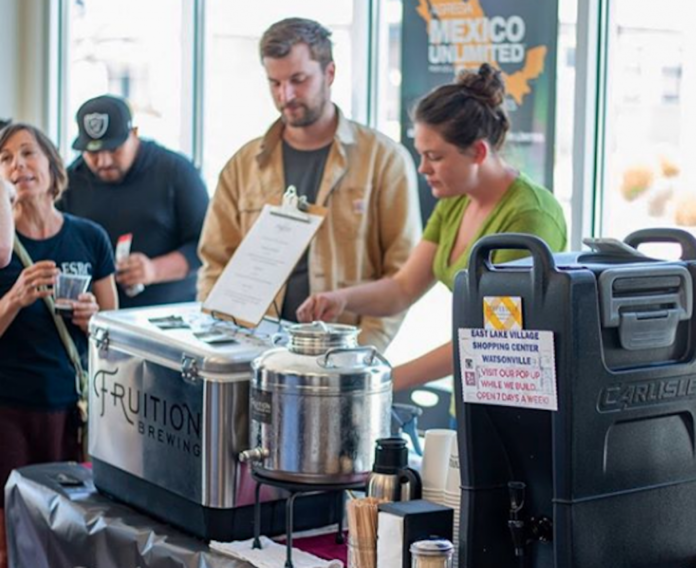Editor’s note: This is the final installment of Brewing Change. The previous installment was published in the Nov. 16-20 edition.
WATSONVILLE — To say home brewing has played a part in David Purgason’s life would be a gigantic understatement.
Brewing helped him meet his partner Tallula Preston. He wrote his 20-page senior thesis at UC Santa Cruz on the craft, touring breweries across the state and breaking down the process of making beer from grain to glass. And it nearly took his life in 2017, as a freak accident while working at Venus Spirits in Santa Cruz sent him to the hospital with severe burns that covered 60 percent of his body.
Undeterred by the scare and more resilient than ever, he and Preston, another home brewing fanatic, will try to share their passion for craft beer with Watsonville when the pair opens up Fruition Brewing in the coming months.
“I love brewing beer,” said Purgason, 28, whose brewpub will occupy a 4,440-square-foot location in the East Lake Village Shopping Center.
Added Preston, 31, jokingly: “I don’t think we would’ve signed our lives away if we didn’t love it.”
Sam Akiyama and Jorge Vasquez, business partners at the Akiyama Hopyard just outside of city limits, were brought together by beer, too. The Watsonville natives met while working at Elkhorn Slough Brewing Co. on Hangar Way. Vasquez, 28, was owner Michael Enos’ first employee in 2016, and he remembers his first day on the job like it was yesterday.
“I missed my mom’s birthday dinner because it was my first day of work,” Vasquez said. “She was a little mad then, but she’s cool with it now.”
Vasquez worked his way up from beer tender to brewer after being hired, and also sparked up a friendship with Akiyama, 24, who returned home from college in 2015 and was Enos’ second hire. When Enos talked to Akiyama about starting a hop yard on his family’s former carnation nursery, the latter was hesitant to jump into the trade. But an exploding craft beer scene in the tri-county area, and a dream of continuing his family’s tradition of farming, pushed Akiyama toward growing hops in 2016.
Over the course of three years, Akiyama and Vasquez have built their business into a well-respected hop yard with clients as far as Berkeley.
“It took some convincing to get Sam on board, but here we are,” Vasquez said.
Joked Akiyama: “A few beers later.”
To which Vasquez rebutted: “A little bit more than a few beers later.”
In between a few celebratory brews, Akiyama and Vasquez have spent their days on the farm and in the books. Akiyama earned a degree in biology from Occidental College, and Vasquez chose not to go to college, instead staying home to help his dad run the family business — Joe’s Carbon Solutions. Neither had intensive knowledge about the process of growing humulus lupulus, the bine plant that produces the green cone-shaped flower used in beer, so the two spent several nights reading about the techniques used across the globe in Germany, a couple states over in the Mid-West and just to the north in Oregon.
Three seasons in, the duo — with the help of Akiyama’s grandfather, Isamu — has found a sustainable rhythm to tend to the rapidly growing plant, which climbs floating ropes hanging over the fields at a pace of roughly two feet a day and creates what Akiyama called a “giant green curtain of cones” during the summer and into the early fall.
The Akiyama Hopyard supplies 12 different types of hops, and has hopes of adding more variations in the future.
“They’re pretty resilient plants,” Akiyama said. “It’s a cross between an orchard and a vineyard.”

Hops, shown here by Jorge Vasquez of Akiyama Hopyard, are essential to the beer-brewing process. (Photo by Sergio Vega)
Vasquez said there’s some room to experiment with the way the hops are grown, but explained that the true art happens after they’re picked and incorporated in the brewing process.
“People are trying new things with beer,” Vasquez said. “It’s an exciting time.”
Experimental, boundary-pushing concoctions are what Purgason and Preston take pride in. Mixed fermentation and barrel aging with fruits like coconut, mangoes, nectarines, cherries and blackberries, among others, is nothing new for them. They brew everything from a simple pilsner to a dry stout aged in añejo barrels with coca nibs, coffee, vanilla beans and milk sugar.
“We like all kinds of beer,” Purgason said. “I think that just having a diverse portfolio and brewing a wide range of styles is important, because people are always looking for something new. Being able to offer something for all types of beer lovers is huge. We want to do a little bit of everything.”
That experimentation, Purgason and Preston agreed, is what makes the arduous brewing process fun.
“I think a lot of people start out with the art portion,” Purgason said. “You’re making this thing, brewing it on your stove, it’s romantic and fun. But once you want to make the best beer that you can, you really fall into the science aspect of it. You get to marry those things.”
Added Preston: “There’s an art and a science. It’s a beautiful melding of the two.”
•••
Faith in the future
Watsonville City Councilman Felipe Hernandez last year attended a conference in Monterey put on by the International Council of Shopping Centers hoping to find an answer — or at least a few suggestions — of how to rebuild Watsonville’s struggling downtown.
There was a common theme in nearly every workshop he attended and speech he heard: millennials.
Attendees and keynote speakers were not blaming the generation — most commonly considered people born between the early 1980s to mid-‘90s — for the decline of downtowns and shopping centers. Instead, they were trying to teach one another how to reconstruct their economies around their tastes.
Gone are the days where 20- or 30-something-year-olds flocked to big box stores in downtown to spend their hard-earned dollars. That’s not to say that millennials buy everything from their smart phones and computers, as a 2017 report from Coupon Follow found a majority of millennials still make most of their purchases offline. Rather, millennials are spending their money in different ways.
Clothes and other physical products don’t mean much anymore — the same report from Coupon Follow found 80 percent of millennials are heavily influenced by price and that the generation is fueling a resurgence in thrift shops. Millennials are forking over more money for experiences, like concerts, hanging out at “craft” coffee shops and breweries, and eating at hip, expensive restaurants — things that struggling downtowns do not offer.
“A lot of people will say that millennials don’t have money, that they don’t spend money. That’s not true,” Hernandez said. “They do spend money, but you have to give them things to spend it on.
“I always hear, ‘I remember the days of Woolworths, Ford’s and Gottschalks.’ But those stores are gone. Those days are gone … It’s a new generation and we have to catch up.”
Watsonville’s downtown has mostly had to play catch up over the last three decades. The businesses that once made Main Street feel cozy and welcoming were in decline during the 1980s, and the devastating Loma Prieta earthquake in ’89 only further exasperated business owners.
Surrounding cities bounced back from the quake, but Watsonville never quite recovered. Ford’s Department Store opened two years to the minute after downtown was left in shambles, but the company went bankrupt a year later. Gottschalks quickly filled the vacancy, but the recession forced the department store to close its doors in 2009. The building in the heart of the city still lies vacant today, as does the historic Fox Theater and the Porter Building — the two structures that welcome visitors entering downtown from the south.
“Times were tough during the ‘80s, downtown was already in decline and the quake was kind of the nail in the coffin,” Hernandez said. “Things can change, but we have to be a part of that change.”
Hernandez said he sees Fruition — and the brewpubs that could follow after the city council’s recent decision to add the type-23 license to the municipal code — as a “catalyst” for Watsonville to finally find an identity and direction for its downtown, one based in farm-to-fork restaurants that showcase the city’s deep agricultural roots.
If Purgason and Preston can show the city and community that a brewery in the heart of a residential area can revive a staggering shopping center and district, a renaissance of Watsonville’s downtown around the trade — and the new generation — could become reality.
“The future of our downtown will depend on their success,” Hernandez said, “and I say that because I have confidence in them.”
When asked if they felt the pressure from the community to succeed, Preston said: “We have no other option but to succeed. We’re all in.”
But will Watsonville be?
“I guess time will tell,” Purgason said.
•••
Tony Nunez can be reached at tn****@********an.com or 761-7335.













